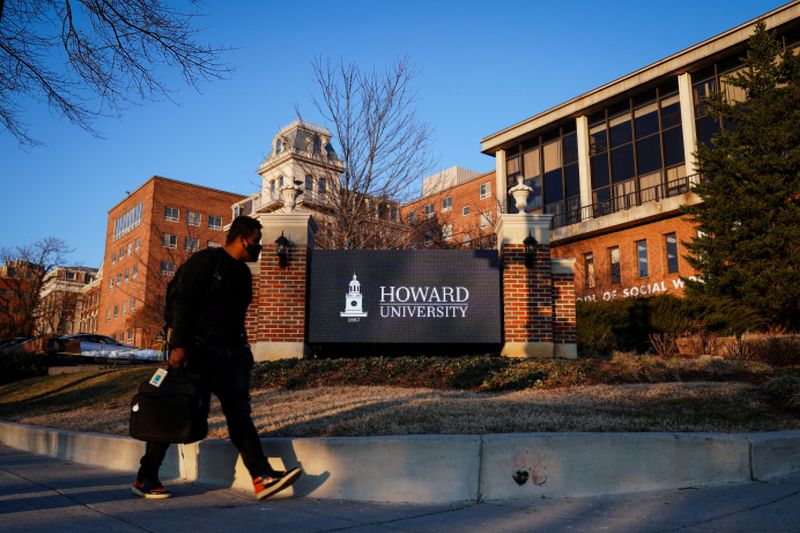WASHINGTON (Reuters) -President Joe Biden announced on Wednesday a long-awaited plan to cancel billions of dollars in student debt, making good on a campaign promise to aid debt-strapped younger Americans even as some Republicans argue the move could worsen inflation.
HOW MUCH WILL BE CANCELED AND FOR WHOM? The government will cancel up to $10,000 in student loan debt for borrowers making less than $125,000 a year, or $250,000 for married couples. Students who received Pell Grants, low-interest federal loans to benefit lower-income college students, will have up to $20,000 of their debt canceled.
Cancelling $10,000 in student loan debt for every borrower would cost the U.S. government $321 billion, the New York Federal Reserve calculated https://libertystreeteconomics.newyorkfed.org/2022/04/who-are-the-federal-student-loan-borrowers-and-who-benefits-from-forgiveness in April, but the income cap means the actual cost will be lower than that.
The New York Fed estimated that forgiving $10,000 per borrower would eliminate student debt for 11.8 million borrowers, or 31% of the total number. The White House said that figure will be 20 million borrowers. Nearly 90% of those borrowers will make under $75,000 a year, the White House said.
HOW MUCH WILL THIS COST?
Biden administration officials declined to provide a specific bottom-line figure on the total cost of the student debt relief plan, saying it depended on how many people apply and qualify for it. But private economists have estimated that it could add $300 billion to $600 billion to the federal debt.
The University of Pennsylvania-Wharton Budget Model estimated https://budgetmodel.wharton.upenn.edu/issues/2022/8/23/forgiving-student-loans that a one-time $10,000 debt forgiveness would cost $300 billion, while former Harvard University economist Jason Furman tweeted https://twitter.com/jasonfurman/status/1562503985529233410 a figure of "roughly" $500 billion. The Committee for a Responsible Federal Budget think tank estimated https://www.crfb.org/blogs/new-student-debt-changes-will-cost-half-trillion-dollars that with $20,000 in debt relief for some borrowers, the cost would reach $440 billion to $600 billion over 10 years.
HOW BIG IS AMERICA'S STUDENT DEBT PROBLEM? U.S. borrowers hold about $1.75 trillion in student debt, according to the latest Federal Reserve figures https://www.federalreserve.gov/releases/g19/HIST/cc_hist_memo_levels.html. The vast majority of that, some $1.62 trillion, is held by the federal government.
The cost of higher education has skyrocketed in the United States in the past three decades, doubling at private four-year colleges and universities and rising even more than that at public four-year schools, according to research https://research.collegeboard.org/media/pdf/trends-college-pricing-student-aid-2021.pdf from the nonprofit College Board.
The debt is split among 43 million borrowers, a figure that includes students and their parents or other family members, but is dominated by borrowers under age 40, the New York Fed said.
WHEN WILL BORROWERS WITH REMAINDER NEED TO REPAY?
A COVID-19 pandemic-related program that paused federal student loan payments, started under Biden's Republican predecessor Donald Trump, will be extended until the end of this year. Any borrowers with remaining balances after debt forgiveness would start making payments again in January.
The Education Department is also proposing a rule to halve the amount undergraduate borrowers need to pay monthly to 5% of discretionary income, and forgive any remaining loan balances after 10 years.
IS THERE A TAX PENALTY?
Student loan amounts forgiven under the program will not be treated as taxable income, unlike other canceled debts, according to a U.S. Treasury official. This exclusion is consistent with a provision in last year's American Rescue Plan COVID-19 relief act that made any student loan forgiveness tax-free through 2025.
WHO WILL NOT BENEFIT
Excluded from the program are borrowers who earn more than $125,000 a year, or $250,000 for married couples. The White House said no high-income individual or high-income household, which it defines as in the top 5% of incomes, will qualify.
HOW COULD THIS IMPACT INFLATION?

Republicans opposed to the plan and some economists, including former Treasury Secretary Larry Summers, have argued that new consumer spending power unleashed by forgiving loans could drive up prices for homes, cars and other consumer goods.
The White House and some economists including Moody's (NYSE:MCO) Mark Zandi have said they believe the impact of restarting loan payments in 2023 will be deflationary.